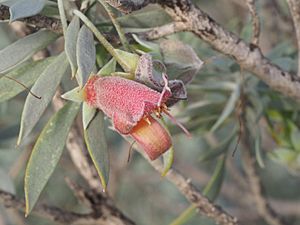Silver poverty bush facts for kids
The Silver Poverty Bush (Eremophila pterocarpa) is a special plant found only in Western Australia. It's also called the Winged-fruited Eremophila. This plant is a bushy shrub that stands tall. It looks silvery because most of its parts are covered in a fine, powdery layer. It belongs to the figwort family, called Scrophulariaceae.
Quick facts for kids Silver poverty bush |
|
|---|---|
 |
|
| Eremophila pterocarpa subsp. pterocarpa leaves and flowers | |
| Scientific classification | |
| Genus: |
Eremophila (plant)
|
| Species: |
pterocarpa
|
Contents
What the Silver Poverty Bush Looks Like
The Silver Poverty Bush is a thick, round shrub. It usually grows about 2 meters (6.5 feet) tall. Sometimes, it can even reach 5 meters (16 feet) high.
Leaves and Stems
The leaves of this plant grow close together. They are long and narrow, like a spear tip. Each leaf is usually between 14 and 40 millimeters (about 0.5 to 1.5 inches) long. They are also about 1 to 5.6 millimeters (0.04 to 0.2 inches) wide. Both the leaves and the stems are covered in tiny, soft hairs. These hairs make the plant look like it's dusted with silver powder.
Flowers and Fruit
The flowers of the Silver Poverty Bush can be red or yellow. They grow one by one where the leaves meet the stem. Each flower sits on a stalk about 10 to 16 millimeters (0.4 to 0.6 inches) long. The flowers have five parts called sepals, which are narrow and shaped like an egg.
The petals are the colorful parts of the flower. They are joined together to form a tube. This tube is about 14 to 24 millimeters (0.5 to 0.9 inches) long. At the end of the tube, there are five small lobes. Just like the leaves, the sepals and petals also have a dusty coating of fine hairs.
The plant usually flowers between June and September. After the flowers, the plant grows flat, dry fruits. These fruits have papery wings, which is how the plant got its name "winged-fruited eremophila."
Plant Names and Types
The Silver Poverty Bush was first officially described in 1904. This was done by a person named William Vincent Fitzgerald. The scientific name pterocarpa comes from ancient Greek words. "Pterón" means "wing" or "feather." "Karpós" means "fruit" or "grain." So, pterocarpa means "winged fruit," which describes the plant's special fruits.
Different Kinds of Silver Poverty Bush
There are two main types, or subspecies, of the Silver Poverty Bush:
- Eremophila pterocarpa subsp. pterocarpa : This type has flat leaves. Its leaves are about 2 to 5.6 millimeters (0.08 to 0.2 inches) wide.
- Eremophila pterocarpa subsp. acicularis : This type has very thin, needle-like leaves. They are only about 1 to 2 millimeters (0.04 to 0.08 inches) wide. These leaves also have a small groove on their underside.
Where the Plant Grows
The Eremophila pterocarpa subsp. pterocarpa type grows in areas like Cape Range National Park, Shark Bay, and Meekatharra. It likes to grow in sandy clay or in soils that come from limestone. You can find it in flat areas or places with salty soil.
The Eremophila pterocarpa subsp. acicularis type is found between Wiluna and places like Neds Creek and Earaheedy. This type prefers rockier, saltier places to grow.
How We Protect This Plant
Good news! Both types of the Silver Poverty Bush are considered "not threatened." This means they are not in danger of disappearing. The Government of Western Australia's Department of Parks and Wildlife keeps track of them.
Growing Silver Poverty Bush in Gardens
People like to grow the Silver Poverty Bush in gardens because of its pretty silvery-grey leaves. Its winged fruits and dusty pink to red flowers are also very attractive. It's a tough plant that can live for a long time. Some plants grown in gardens are over 30 years old!
You can grow new plants from cuttings. You can also graft them onto other plants called Myoporum species. This plant can grow in many different kinds of soil. It doesn't mind salty, alkaline, or clay soils.
In nature, this plant can handle long dry periods and even occasional floods. Giving it water in a similar way can help it flower more. It can also handle frosts and can be pruned back hard when it's mature.
Images for kids



